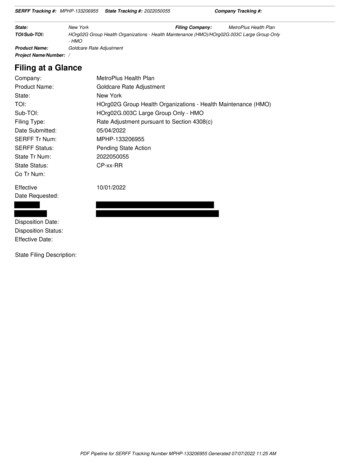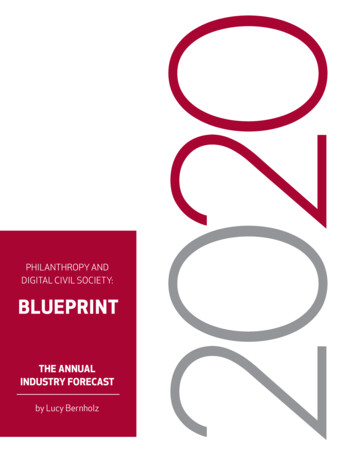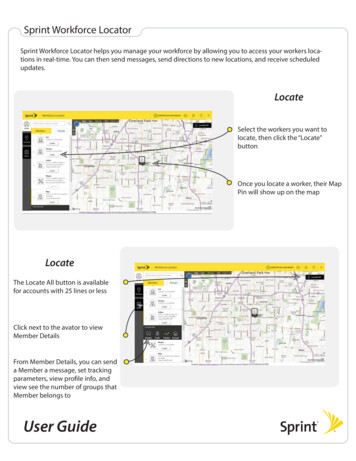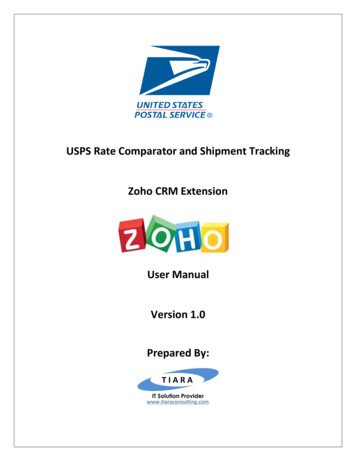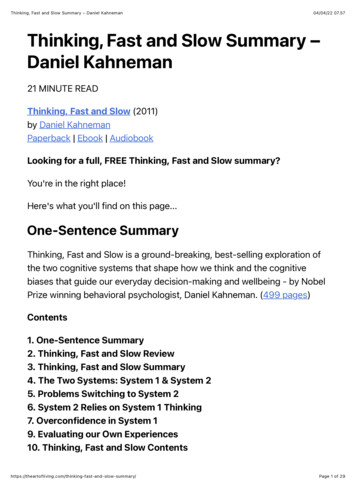Transcription
COGNIZANT 20-20 INSIGHTSFast-TrackingDigital:A Blueprint forCommunicationsServicesProvidersExecutive SummaryFor communications services providers (CSPs),becoming a digital business is no longer a choice;it’s essential for remaining relevant and competitive. Today’s customers expect best-in-class,omnichannel experiences that simplify and personalize communications and transactions. Whenit comes to digital transformation, the questionisn’t if to start, but how and where. To find theanswer, CSPs must look at the wider landscapeand ask: What forces are shaping the industry, andwhat challenges will they bring? What strategic priorities can address theseissues? How can a new delivery model accelerate thelaunch of new digital services?By following a pragmatic,viable plan, CSPs can acceleratetrue digital transformation. What’s the right revenue-generating, datapowered marketing model for those services? How can we use these insights to enable a fulldigital transformation?Cognizant 20-20 Insights January 2018
Cognizant 20-20 InsightsThis white paper presents an actionable, pragmatic blueprint that CSPs can use as they shifttheir role from communications services providerto digital services provider (DSP). By combiningadvances in human science and technologies,companies can remove the costs of legacy architectures, compete effectively with over-the-top(OTT) players, and realize profitable growth.Today’s customers expect best-inclass, omnichannel experiencesthat simplify and per sonalizecommunications and transactions.Fast-Tracking Digital: A Blueprint for Communications Services Providers 2
Cognizant 20-20 InsightsFORCES SHAPING &CHALLENGING THE INDUSTRYWhen compared with other industries, CSPsface powerful headwinds. They lag behind theircounterparts in other sectors, both in currentperformance and strategic positioning. Theseissues can be traced in part to the CSP industry’spoor standing in the S&P 500 Index year on yearfor the past ten years. Yet in some markets, prospects for the industry have never looked better.Numerous developments are driving dramaticchanges within the CSP space — disrupting established value chains and business models. Still, thesame trends are opening non-traditional growthprospects and creating new opportunities forindustry players.Disruptive technologies such as OTT videostreaming and the Internet of Things’ (IoT) smarthome devices, are at the forefront of this change.Indeed, these systems now form the core ofevery telco’s capabilities. And since they play amajor role in driving new customer experiencesand engagement models, these capabilities represent a potentially huge new revenue source forcarriers.Nonetheless, as digital technologies becomemore ubiquitous, CSPs find themselves mired inlegacy technologies, including business supportsystems (BSS) and operations support systems(OSS). This predicament can be the result ofmergers and acquisitions, compartmentalizedapproaches, a lack of architecture governanceand IT strategies, or failure to prioritize, fund,and modernize the IT infrastructure in a thoughtful, holistic manner.The complexity of BSS and OSS applicationshas also increased due to new technologies,solutions, and services. Business leaders musttherefore be extremely careful to ensure thattheir key performance indicators (KPIs) alignwith changes in their technology strategies andinvestments. Even so, in our view many CSPsacross Europe still have a long way to go in theirdigital transformation journey.Yet this transformation is essential. CSPs rightlywant to differentiate their customers’ experiences, but in order to achieve that objective, theyneed to increase their reliance on analytics togain actionable insights, deploy products fasterthrough a digital-ready infrastructure, and createnew customer engagement models that lead todeeper, longer-term relationships with consumers and other key stakeholders. Simultaneously,communications services providers must workto heighten efficiencies across their businessunits — a task that requires integrating existingcapabilities within the context of a larger digitalecosystem and industry-specific platforms. (SeeFigure 1, next page).Fast-Tracking Digital: A Blueprint for Communications Services Providers 3
Cognizant 20-20 InsightsAn Integrated Digital Telco Ecosystem1Digitized Operational IT &Product/Services Development IT2Two-Speed IT DeliveryLifecycle Driven by DevOpsCloud-EnabledOperational ITIoT/M2M/Mobility Integrated74D(SP)(DS)PA service providerwhose operationsare digitalizedA provider ofdigital -Driven: Customer,Social Media & NetworkOmnichannelExperience126Self-Service IncludingCare & ProvisioningCloudServicesData Monetization& AdvertisingM-PaymentsvNGNSupported by anagile, virtualized,next-generationnetworkDSP D(SP) (DS)PvNGNFigure 1STRATEGIC CONSIDERATIONSAside from dealing with overly complex, rigid,and sluggish BSS and OSS systems, CSPs facenumerous other challenges, including customerretention (especially amid the disruptive effectsof OTT competitors and ever-growing smartphone usage); rising Cap-Ex requirements, andthe need to accelerate time to market for newservices.So how can CSPs address these issues? A numberof analyst reports, including the EY Global Telecommunications Study, “Navigating the Road to20201,” cited customer experience managementand organisational agility as CSPs’ top two priorities by almost two-thirds (63%) and amongthe top three by as much as 88%. (See Figure 2,next page).The results of the survey can help inform a setof six strategic priniciples for CSP organisations: Customer experience management (CEM)drives customer retention. CSPs shoulddeploy a seamless, omnichannel strategyby design. They should also offer quad-playservices, as well as build-your-own-contractsand self-serve options enabled by artificialintelligence (AI to create “sticky” offeringsthat will maintain retention levels). Organisational agility helps CSPs openthe door to digital. The ability to connectnetworks and launch new services quicklyin response to changing customer needs iskey, and will help battle the disruptive forcesof OTT players. Organisational agility alsoopens the possibility to offer complementaryFast-Tracking Digital: A Blueprint for Communications Services Providers 4
Cognizant 20-20 InsightsA View from the CEO SuiteSTRAGEGIC PRIORITIES1. Customer Experience Management2. Organisational Agility3. Business Cost Control & Investments4. Network Upgrades & Modernisation5. New Digital Services Deployment6. Improved IT Systems & ProcessesFigure 2 services, and play with over-the-top (OTT)providers as an integrated digital servicesplatform — thus futureproofing infrastructureinvestments. Improve cost control and productivity toenhance existing processes and drive outinefficiencies. Consider Liberty Global. Thisinternational CSP has embarked on its strategy to grow its EBITDA performance by 7%to 9% over three years.2 Half of this growthwill come from Op-Ex efficiencies/savingsthrough shifting 4,500 people from operating units into a shared service centre, as wellas restructuring to create just one CTO, oneCIO, one network operations centre (NOC),and one data centre (DC). Additionally, thecompany consolidated the number of vendorsfor its outsourced call centre operations from68 (at an annual cost of 250 million) to justfive. And its procurement function is leadingthe way with 0.5 billion in savings. In themeantime, the business is looking to stimulaterevenue growth by focusing on several initiatives: new build (through “Project Lightning”in the North of England); the fastest broad-INDUSTRY CHALLENGES Customer Retention Disruptive Competition from OTT Increase in Smartphone Usage Increasing Cap-Ex Complex, Rigid & Slow BSS / OSS Faster Go-to-Market for New Servicesband speeds in the UK; going mobile (in nineEuropean markets); and becoming a “thick”MVNO with more ownership of customer data.Liberty Global is also focusing heavily on theB2B and SME segments, where its current UKmarket share is just 4%. Upgrade and modernize networks. Datatraffic continues to grow; yet more important, the characteristics of that traffic arechanging. For example, according to Cisco’sVisual Networking Index, over three-fourths(78 percent) of the world’s mobile data traffic will be video by 2021.3 This means CSPsmust either invest in a hardware-intensivenetwork infrastructure or rely increasingly oncloud services. The goal is to create a flexible,automated, and programmable network thatreduces Cap-Ex (which is currently rising at aCAGR of 5%) and deliver services to marketfaster. Software-defined networking (SDN)and network function virtualisation (NFV) arethe tools needed to achieve this objective. Onthe one hand, SDN provides a centralised viewof the distributed network to more efficientlyorchestrate and automate network services.Fast-Tracking Digital: A Blueprint for Communications Services Providers 5
Cognizant 20-20 InsightsOn the other hand, NFV allows for faster services innovation and provisioning. Moreover,both of these telco cloud technologies havebeen shown to reduce Cap-Ex. New digital services deployment. Technologies such as SDN and NFV enable faster andmore efficient deployment of new services.CSPs need to orchestrate these new offerings across hybrid virtual/physical networks— requiring their operations support systemsto adapt. Otherwise, the principal benefitsof NFV — agility, dynamic performance, andreduced costs are lost. That’s why initiatives such as TM Forum’s ZOOM (zero-touchorchestration, operations and management)and standardised APIs that make it easier todeploy NFV and SDN are so important. Digital applications and processes redefine CSPs’ IT investments — from systemsof record to systems of intelligence. Theseadvances also enhance the platforms thatunderpin companies’ revenue-generatingprocesses, such as quote-to-cash (Q2C),order-to-fulfilment (O2F), and customer-to-advocate (C2A). By adding technologies suchas machine learning and predictive analyticsto the mix, CSPs can also personalise theiroffers. And by applying behavioural science,or “thick” data, they can add more contextand human insight to their customer interactions; for example, by making offers tocustomers via “next best action” — a leadingchannel for digital innovation that also acts asa catalyst for change in the network.HOW NEW DELIVERY MODELSACCELERATE THE LAUNCH OFDIGITAL SERVICESThe strategies we highlighted are a core partof CSPs’ evolution to digital services providers(DSPs). A digital BSS overlay architecture canfacilitate this step forward by allowing DSPs tobring new digital services to the market quicklyand efficiently. And because the architectureexists as an overlay, CSPs don’t need to rip andreplace their legacy support systems. Instead,they can focus on bringing new digital servicesto market in the shortest possible time frame.(See Figure 3).The Digital BSS OverlayDigital BSSCognizant Digital BusinessOmnichannelFrontOfficeExternal JourneyB2B, B2C, B2VInternal JourneySales, AM, CSRDigital Experience cial Product CatalogueQuoteContractOrderInsight Strategy & DesignIdea Couture, ReD, Zoom,NetcentricValueHuman-CenteredUI/UX Design,Ideation to RealityDigital MarketingOperationsDedicated PracticesAdobe, Pega, SFDC, MicrosoftAcceleratorsQ2C, O2F & C2AProcess AutomationInteractive, DigitalSolutions & ArchitectcurePredefined ProcessAPIsTechnical Product CatalogueBackOfficeProvisioning& ActivationRevenueAssuranceMediation& BillingData Layer — Analytics/MLFigure 3Fast-Tracking Digital: A Blueprint for Communications Services Providers 6
Cognizant 20-20 InsightsA DSP must have a clear understanding of theexperiences that it creates for differentcustomer types. It must also have the abilityto grasp what its customers are experiencing —in other words, to put itself in their shoes.Within the digital BSS overlay, digital servicesproviders must create a “digital blueprint” forconnecting external and internal entities andprocesses, and affording a truly digital, omnichannel experience. We typically work withCSPs to develop a human-centred approach thatenables them to design external customer experiences from a user perspective across all digitaltouchpoints and define underlying processesacross internal functions such as Q2C, O2F, andC2A on intelligent systems. (See Figure 4).Our work in this space reveals that true value iscreated at the points where the DSP’s offeringsintersect with human activities — including theexperiences of partners (B2B), end customers(B2B2C), direct customers (B2C) and industryverticals (B2V). Combining the collective insightof these entities sets the path for the next technology paradigm, 5G roll-out, which will cater tothe needs of industry-specific verticals such asthe automotive sector, and use cases such as theconnected car.Recently, we engaged with a leading tier-1 CSPin Europe to help the company develop a retailin-store experience (external journey) designedwith a human lens. Early signs indicate fewerwalkout rates and projected 25% incrementalrevenue over five years.Transformational, end-to-end human-centreddesign starts by describing an ideal interactionbetween an individual and the DSP and the benefits each can realise from that experience.Re-imagining the Digital Customer ExperienceInsightsAs-isReimagine// Context Labs (i.e.group discussions withconsumers / focusgroups)// Mapping the currentcustomer journey(including pain pointsand breakpoints)// Ethnographicresearch// Understandingcurrent state// Strategic foresight(understandingemerging cultural,behavioural, andtechnological shiftsinfluencing the futurestate)// B2B, B2C, B2B2C// End-to-endcustomer journey forall segments// All user typesdigitised and enabledwith a digital identity// B2B, B2C, B2B2C, B2VFigure 4Fast-Tracking Digital: A Blueprint for Communications Services Providers 7
Cognizant 20-20 InsightsOnce their new digital services deliverymodel is in place, DSPs can focuson continuous optimisation using acombination of “thick,” or human data,and big data generated by devices, OSS/BSS, and network probes.To properly align these initiatives, we recommend that DSPs adhere to three imperatives:and technology strategies from both marketand customer perspectives. View offerings from the outside-in ratherWe base our approach on a proven methodologydriven by human insight — taking into account alltouchpoints, up to and including the ultimate enduser — the consumer.than the inside-out. A DSP must have a clearunderstanding of the experiences that it creates for different customer types. It must alsohave the ability to grasp what its customersare experiencing — in other words, to put itselfin their shoes. This requires a human insightdriven methodology that examines bothcurrent and future states. Align internal functions across teams andlevels. A DSP’s back-office order-to-fulfilmentprocesses are as important as its front-officeprocesses when it comes to the visible pointsof interaction. Thus, the value for individualcustomers and the DSP must align throughoutthe process, end-to-end, with the technologysupporting that goal. Create visualisations as shared references.Aligning processes to ensure positive userexperiences requires DSPs to understand theinterdependencies among digital systemsand processes, and how users across thebusiness will navigate a patchwork of newinterfaces and interactions on their own. Bymapping individual experiences, companiescan create a tangible model for DSP teamsto rally around. From a broader perspective,these concepts can be used to align businessWe cover all aspects of B2B2C mapping, including aligning DSPs’ strategies with users’ buyingexperiences and patterns. Armed with this levelof insight, DSPs can employ an analytics-basedplatform to continuously optimise their customerservices within a fully digitized environment thatequips each player in the value chain with a digital identity.AN OPTIMISED, REVENUEGENERATING MARKETING MODELOnce their new digital services delivery model is inplace, DSPs can focus on continuous optimisationusing a combination of “thick,” or human data,and big data generated by devices, OSS/BSS, andnetwork probes. This capability tells companiesnot only what their customers are doing, butwhy. When fed into a “next best action” engine,these powerful insights enable DSPs to deliverprecise, timely, and contextual offerings andservices. Adding journey analytics (sequentialcustomer experiences) to the mix allowsfor meaningful customer interactions acrosschannels.Fast-Tracking Digital: A Blueprint for Communications Services Providers 8
Cognizant 20-20 InsightsFor example, a customer might go through several steps to make a potential purchase via aDSP’s app, only to close the app without completing the transaction. The customer might thendecide to visit a physical store to make their purchase. Imagine if, rather than having to re-startthe purchase process, the customer could immediately begin from the point where they closedthe app. This is what it means to offer a trulyomnichannel experience. (See Figure 5).ENABLING DIGITALTRANSFORMATION:CONVERGING THREE CLOUDSWe see the converging of three technology clouds as core enablers of CSPs’ digitaltransformation: The Telco (network) cloud: SDN/NFV (private The Enterprise (public) cloud: Q2C, O2F, andC2A (customer to advocate) processes The Operator IT cloud: OSS/BSS overlayTogether, these Web-based systems provide theorganisational agility that global CSPs cite as keyto launching new products and services quicklyand offering a superior customer experience thatis omnichannel by design. Placing the customerat the centre of innovation and experience designalso allows them to dramatically reduce costs.We recommend that companies tackle digitaltransformation in phases. The first is to connect network virtualisation technologies, suchas SDNs, with centralised orchestration (OSS) tosupport the roll-out of agile, programmable networks in multiple countries, and ensure that thecustomer experience is human-centred.cloud from NEP to the CSP)An Optimised Marketing Model Omnichannel design Breakdown operational silos Force integrated operationsRedesign CustomerJourneysInternal Q2CProcesses Apply technology to journeys Compounding effect of improvementAnalyticsData — Journeys,Operations, Social,Devices, NetworksNext GenerationOperating ModelAnalytics Driven360 Analytics Personalised and relevant engagement Proactive intervention (Predictive Analytics) CEM KPIs — on-boarding time, TTM newproducts, capacity on demand, lead conversionrates, quoting time and efficiency Real-time journey optimisation Define your own contract Chatbot enabled customer careFigure 5Fast-Tracking Digital: A Blueprint for Communications Services Providers 9
Cognizant 20-20 InsightsThe network cloud will grow as it is enriched withOSS/BSS, analytics, and radio. Orchestrationwill allow the network and enterprise clouds toconnect; behavioural engineering will bring bigand thick data together in the experience design.The next critical phase involves the addition ofcustomer experience management (CEM) anda radio access network (RAN). The networkcloud will grow as it is enriched with OSS/BSS,analytics, and radio. Orchestration will allowthe network and enterprise clouds to connect;behavioural engineering will bring big and thickdata together in the experience design. Theexperience itself will be continually optimised toensure that the customer’s digital journeys aredynamic, and evolve with the CSP’s digital capabilities to provide the best possible services, asdepicted in Figure 5.By 2020, the vision is to achieve comprehensive organisational agility — a single, scalable,integrated, cloud-based infrastructure with optimised services. (See Figure 6).LOOKING FORWARD: ACCELERATING THE TRANSITION TODIGITAL SERVICES PROVIDERThe final leg of a CSP’s digital transformationis the transition to a digital services provider.Leading DSPs such as Facebook and LinkedInare experts at engaging with customers in timelyand relevant ways. CSPs have to make this leap,but to date haven’t developed the capabilitiesto enable real-time, relevant customer engagements — from upselling new services to providingcustomer loyalty notifications.CSPs do hold one critical advantage, however.They have already amassed huge amounts ofdata. As shown in Figure 7 (next page), the keyis to harness this treasure trove and combine itwith thick data to generate insights and experiences that can scale to meet the needs of globalmarkets.The Cloud Transformation TimelineCloud Transformation Will Take 5 – 10 YearsNOWCEMOperator 2020–20252017 NetworkCloudCarrier-grade clouds typicallyin silos following operatorunits.TODAY’S FOCUSNetworkCloudOSS / BSSRadioDistributing & connectingacross the operator’sarchitecture.Logically integrated (private /public / hybrid) cloudinfrastructure, cloud scales &optimised network services.Figure 6Fast-Tracking Digital: A Blueprint for Communications Services Providers 10
Cognizant 20-20 InsightsA Data Driven Experience Engine Listening to the voice of the customer(sentiment, behaviour, network and IT) Efficient redefined customer journeysfor future business models Precision NBA Continuously optimises customer journeysEXPERIENCEHuman Centred Wind tunnelling — journey adaptation tolocal market needs and user behaviour Omnichannel by design Reference overlayarchitecture CEM KPIs Customer journey analytics(B2B, B2C & B2V)BUSINESS MODELAnalytics-DrivenTECHNOLOGYDigital BSS Proactive customer care Process automation, Q2C,O2F, C2A Underpinned by platformsof intelligenceANALYTICS360 View Contextual analytics — connecting thick andbig data “Insight to Algorithms” — stronger algorithms Real-time, historical and recent data captureFigure 7FOOTNOTES1Global Telecommunications Study: Navigating the Road to 2020. d-to-20202Liberty Global’s (LBTYA) CEO Michael Fries on Q1 2016 Results — Earnings Call Transcript. nings-call-transcript?page 23Cisco Visual Networking Index: Global Mobile Data Traffic Forecast Update, 2016–2021. -paper-c11-520862.pdfABOUT THE AUTHORAvtar ChaggarDigital PartnerCommunications, Media &TechnologyAvtar Chaggar is a Digital Partner within Cognizant’s UK-basedCommunications, Media and Technology (CMT) business unit. Inthis role, he leads digital transformational strategies for communications clients by combining technological advances in humanscience and innovations in customer experience management,as well as operational and business support systems (OSS/BSS),cloud and analytics. Avtar is a highly experienced subject-matterexpert in the mobile communications sector — delivering highimpact business outcomes to C-level audiences within the tier-oneservice provider space. Over the last 20 years, Avtar has focusedon leading-edge digital technologies, starting from the ground upto provide a comprehensive understanding of digital technologies.Avtar is a Chartered Engineer, and holds a BEng from King’s College London and an MBA from Henley Business School. He can bereached at Avtar.Chaggar@cognizant.com cking Digital: A Blueprint for Communications Services Providers 11
ABOUT COGNIZANT DIGITAL BUSINESSCognizant Digital Business helps our clients imagine and build the digital economy. We do this by bringing together human insight, digitalstrategy, industry knowledge, design, and new technologies to create new experiences and launch new business models. For more information, please visit: www.cognizant.com/cognizant-digital-businessABOUT COGNIZANTCognizant (NASDAQ-100: CTSH) is one of the world’s leading professional services companies, transforming clients’ business, operating andtechnology models for the digital era. Our unique industry-based, consultative approach helps clients envision, build and run more innovative and efficient businesses. Headquartered in the U.S., Cognizant is ranked 205 on the Fortune 500 and is consistently listed among themost admired companies in the world. Learn how Cognizant helps clients lead with digital at www.cognizant.com or follow us @Cognizant.World HeadquartersEuropean HeadquartersIndia Operations Headquarters500 Frank W. Burr Blvd.Teaneck, NJ 07666 USAPhone: 1 201 801 0233Fax: 1 201 801 0243Toll Free: 1 888 937 32771 Kingdom StreetPaddington CentralLondon W2 6BD EnglandPhone: 44 (0) 20 7297 7600Fax: 44 (0) 20 7121 0102#5/535 Old Mahabalipuram RoadOkkiyam Pettai, ThoraipakkamChennai, 600 096 IndiaPhone: 91 (0) 44 4209 6000Fax: 91 (0) 44 4209 6060 Copyright 2018, Cognizant. All rights reserved. No part of this document may be reproduced, stored in a retrieval system, transmitted in any form or by any means,electronic, mechanical, photocopying, recording, or otherwise, without the express written permission from Cognizant. The information contained herein is subject to change without notice. All othertrademarks mentioned herein are the property of their respective owners.TL Codex 3265
Fast-Tracking Digital: A Blueprint for Communications Services Providers 4 STRATEGIC CONSIDERATIONS Aside from dealing with overly complex, rigid, and sluggish BSS and OSS systems, CSPs face numerous other challenges, including customer retention (especially amid the disruptive effects of OTT competitors and ever-growing smart-
